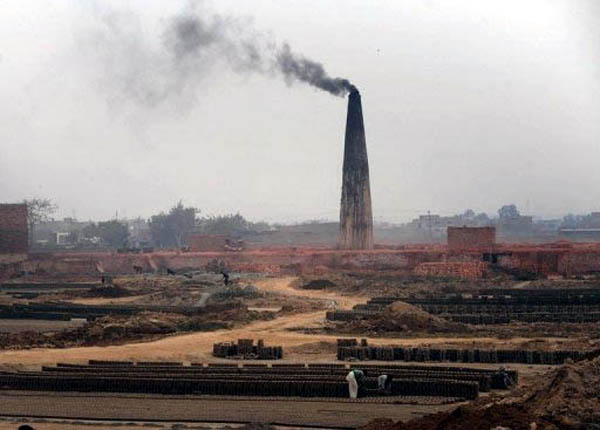
Suhail Bhat
SRINAGAR, Feb 15: In a brazen violation of environmental laws, majority of the brick kilns in Kashmir are not implementing the specified and necessary measures for minimizing the pollution levels.
Out of 300 brick kilns’, the Central Kashmir district Budgam has 230 and they are posing threat to the biotic environment in the district.
As per the norms laid out by the State Pollution Control Board (SPCB) the fixed height of chimney should be higher than 115 feet. “This norm ensures that harmful smoke and gases emitted from these kilns are released in the upper atmosphere so that they do not come in contact with the human population,” said Regional Director State Pollution Control Board (SPCB) Mohammad Shafi.
However, situation on ground negates implementation of such measures. “Brick kilns pose a serious threat to the health of the people living close to the kilns. The smoke that comes out of the chimneys contains lethal gases,” says Mushtaq Ahmad, a local resident of Budgam. Another resident said the large amount of dust and smoke coming out from the brick kilns are polluting the local environment and badly affecting the health of people.
The increasing number of patients with chest related diseases also confirmed the damage. Assistant Professor, Dr Naveed Shah at Chest Disease Hospital here said the emission of huge quantity of toxins from brick kilns is causing serious health hazards.
“The brick kilns emit toxic fumes containing suspended particulate matters rich in carbon particles and a high concentration of carbon monoxides and oxides of sulphur causes common occupational lung diseases like Mesothelioma, Asthma, Silicosis and can even cause Asbestosis which is incurable and can result in death at an early stage,” he said.
While the concerned authorities have turned a blind eye towards this grave issue, the people living in the vicinity of these establishments have fallen victim to a number of life-threatening diseases and disorders and to top it up there are other damages caused.
The locals while talking about the various dimensions of concerns caused by these kilns said: “Tippers transporting bricks from these kilns throughout the day also affect the health of the people. We have literally turned deaf due to their noise in addition to the deterioration of roads, which have turned into deserts of dust and we can’t even breathe.”
Dr Naveed said these toxic fumes also affect crops and plants in the areas adjacent to brick fields as against the existing SPCB guidelines suggesting that there should be green belt consisting of three rows of evergreen broad leaved trees around the periphery of each brick kiln.
“The idea of plantation around the kilns was to reduce the range of dispersal of dust and smoke particles,” said Regional Director SPCB. “The smoke and dust also adversely affects visibility, reduces growth of vegetation and it can cause lung cancer and several other ailments after entering into the human body,” he added
Locals said the brick kiln owner flout all rules and regulations. “We have approached all concerned authorities, sent them delegation and representation so that this ecological vandalism be stopped in accordance with the laws and rules. There has been no action as almost all the officials are hand in glove with the kiln operators,” they said.
According to reports, the residents of about a dozen villages are now selling their properties and fleeing to safer and cleaner areas. The environmental degradation caused by these establishments has hampered the growth of vegetation, besides adversely affecting the aesthetic value of the place.
It is believed that air pollution affects wild native vegetation and forests more than agricultural crops due to land degradation as a consequence of utilization of best quality top soil in brick-making which leads to erosion.
Even the flowing water streams nearby are polluted by them.”Many of our springs are polluted now like Shah Naag and brick kilns are using a large area of these Karewas which are most appropriate for Saffron cultivation ruining this priceless gift from nature in the process. The deadly smoke and soot emitted from the kilns has drastically affected the trees and vegetable plantation of the area” said Showkat Hussain, a teacher.

